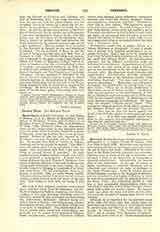

Chevreul, MICHEL-EUGENE, chemist, physicist, and philosopher, b. at Angers, France, August 31, 1786; d. at Paris, April 9, 1889. His father was a physician, who had himself been an investigator and had reached the age of ninety-one years. Educated in his native town at the Ecole Centrale, formerly the university, Chevreul went to Paris at the age of seventeen and obtained a place in the laboratory of Vauquelin, a chemical-manufacturer. Subsequently he became chief of this laboratory. At the age of twenty he began contributing to scientific literature, and at twenty-six had attained the rank of professor at the Lycee Charlemagne. Later he became director of the Gobelins, member of the Academy of Sciences, and was admitted to the Legion of Honor, in which he won every promotion until he ultimately received the Grand Cross. His centennial jubilee in 1886 was a very remarkable demonstration which the Government directed, and in which Chevreul participated with bodily and mental vigor. His funeral, which took place two years and seven months later, was made the occasion of paying great honor to his memory.
Although he is renowned for the extensive range of his work, Chevreul’s fame rests chiefly upon two particular and important lines of investigation which he entered upon and followed up with great success: namely, in chemistry, “The Constitution of the Fats”, and in physics, “The Harmony of Colors”. The former is set forth in his “Recherches chimiques sur les corps gras d’orgine animale” (1823), in which he demonstrated that fats have the constitution of ethereal salts and are neutral glycerine ethers of fatty acids; that is, that they can be separated into their respective fatty acids and glycerine. He demonstrated the reactions occurring when this phenomenon, known as saponification, is brought about by strong bases or strong acids. He distinguished the constituent acids of the common fats and determined their constants. Practical corollaries of this discovery were the establishment of the great industry of stearin candle manufacture and the introduction of glycerine into commerce on a large scale. These researches also led to a broadening amongst chemists of all countries in the study of the theory of constitution of organic bodies.
Chevreul’s position as director of the Gobelins, to which he had been appointed by Louis XVIII, led to his important discoveries, both in the chemistry of dyeing, previously little understood, and in the physics of color and color effect. His papers on the latter subject began in 1828, in the “Memoires de l’Academie”, and his great work, “The Law of Simultaneous Contrast of Colors”, was published in 1839. Similar studies had engrossed the attention of Abbe Hauy, the crystallographer, and of Scherffer, a Jesuit (1754); but Chevreul was able to deduce from a vast number of his own observations the laws governing changes in intensity of tone and shade or modification of color, and particularly the influence of one color on another in juxtaposition. A practical application of this knowledge, together with practical results from the study of dye-stuffs, and the blending of colors in dyeing, served to bring this art to a perfection which, increased again by the variety of dyes obtainable from benzol, has been of the utmost use industrially.
Chevreul also participated in many of the philosophical debates of his century. He strongly combated skepticism and materialism, and constantly asserted that the harmony of the universe and nature, and of man’s life and place in them, demonstrated a wisdom which must be called Divine. To some who had written of him as an advocate of an irreligious science he answered by asserting in an open letter to a friend (published in “Le Bien Public” September 17, 1886) that he wished to be known as a savant, and at the same time a faithful Catholic: “Those who know me”, he wrote, “also know that born a Catholic, the son of Christian parents, I live and I mean to die a Catholic.” While Chevreul will not occupy a place in the history of chemistry as high as his fellow-countryman and contemporary, Dumas, he nevertheless suggests one of the best examples of the union of research with technical practice resulting in changes great enough to affect the history of nations. The following are his principal works: “Lecons de chimie appliquee a la teinture” (1828-1831); “De la loi du contraste simultane des couleurs” (1839); “Essai de mecanique chimique” (1854); “De la baguette divinatoire” (1854); “Considerations sur l’histoire de la partie de la medecine qui concerne la prescription des remedes” (1865); “Histoire des connaissances chimiques” (1866).
CHARLES F. MCKENNA

